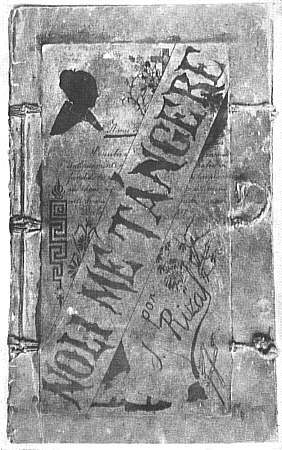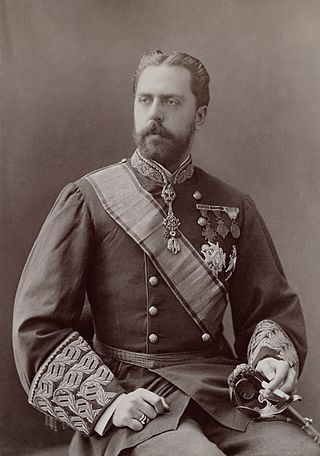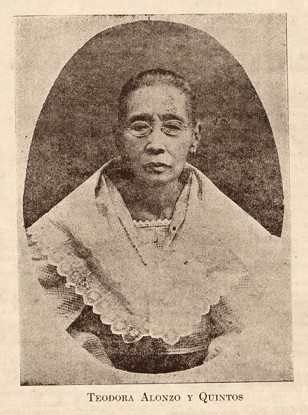This article needs additional citations for verification .(June 2020) |

This is some background on history, popularity, and usage of middle names in the Philippines.
This article needs additional citations for verification .(June 2020) |

This is some background on history, popularity, and usage of middle names in the Philippines.
Christians (as well as certain Muslims, Chinese Filipinos, and others) in the Philippines formerly followed naming patterns practiced throughout the Spanish-speaking world (the practice of having the father's surname followed by the mother's surname, the two being connected by the particle "y", which means "and", such as Guillermo Cu-Unjieng y Araullo). If the second surname starts with i, y, hi or hy, the particle becomes e, following Spanish rules of euphony, as in Eduardo Dato e Iradier . Sometimes this second rule is overlooked.
This practice changed when the Philippines became a United States colony in the early 20th century. The order was reversed to follow the conventional American form "Christian name - Middle name - Surname," which in this case is actually "Christian name - Mother's surname - Father's surname" (Francisco Concepcion Casas or simply Francisco C. Casas). The conjunction y was dropped, although it is still used in certain contexts today (most notably names in criminal records, like the names used in placards used in mug shots, such as shown in the image on the right).
Currently, the middle name is usually, though not always, the mother's maiden name (followed by the last name which is the father's surname). This is the opposite of what is done in Spanish-speaking countries and is similar to the way surnames are done in Portugal and Brazil. The blending of American and Spanish naming customs results in the way Filipinos write their names today.
Furthermore, application forms for various legal documents define the first name as the "Christian name(s)," the middle name as the "mother's maiden surname" (this becomes the basis for the middle initial), and the surname as the "father's surname."
Bearing the mother's maiden surname as the middle name or middle initial is more important to a majority of Filipinos than to use one of the given names as a middle name or middle initial. Filipino culture usually allocates equal value to the lineage from both mother and father except in some prominent families who practice a strictly patriarchal system (usually of Spanish or Chinese heritage).
Exceptions apply in the case of children with single parents. Children born out of wedlock bear their mother's surname as their surname, with no middle name. The unmarried father must resort to legal and administrative procedures if he desires to acknowledge the child as his own and for the child to be registered with his own surname (in which case the child will use the mother's surname as his/her middle name). Exceptions also apply to Filipino children who have non-Filipino descent.
When a woman marries, she may: use her maiden first name and surname and add her husband's surname; use her maiden first name and her husband's surname; or use her husband's full name, but prefixing a word indicating that she is his wife, such as “Mrs.” [1] She may also decline to adopt her husband's surname and continue to use her maiden name since there is no law in the Philippines which obligates a married woman to use the surname of her husband. [2]
Until the middle of the 20th century, it was common for married Filipino women to insert the particle "de" ("of") between her maiden surname and husband's surname (as in Margarita Mangahas de Santos or Margarita M. de Santos), another common Spanish naming custom. However, this practice is no longer common.
Married Filipino women who are professionals may choose to hyphenate their surnames (such as Margarita Mangahas - Santos, instead of simply Margarita Santos or Margarita M. Santos), at least in professional use, and use it socially even if legal documents follow a different naming pattern. This practice allows others to identify them after their marriage and helps others keep track of their professional achievements; otherwise, her unmarried and married names would seem to refer to two different persons (Margarita Gomez Mangahas as compared to Margarita Mangahas-Santos).
Before digitization of records, middle initials and sorting of surnames follow the first letter of the name after Hispanic de, dela, del, delos. For example, the name Jose delos Santos dela Cruz is shortened as Jose S. dela Cruz and surname sorted on the letter C. Today, the middle initial must be the letter D (Jose D. dela Cruz) and surname sorted in the letter D. There have been a few documented exceptions, such as Benigno S. Aquino III, Jose P. Laurel, and Manuel L. Quezon, whose middle initials actually stand for their second given names, that is, Western-style middle names Simeon, Paciano, and Luis respectively.
Surname conventions and laws vary around the world. This article gives an overview of surnames around the world.
When a person assumes the family name of their spouse, in some countries that name replaces the person's previous surname, which in the case of the wife is called the maiden name, whereas a married name is a family name or surname adopted by a person upon marriage.

A surname, family name, or last name is the mostly hereditary portion of one's personal name that indicates one's family. It is typically combined with a given name to form the full name of a person.

A personal name, full name, or prosoponym is the set of names by which an individual person is known, and that can be recited as a word-group, with the understanding that, taken together, they all relate to that one individual. In many cultures, the term is synonymous with the birth name or legal name of the individual. In linguistic classification, personal names are studied within a specific onomastic discipline, called anthroponymy.

Noli Me Tángere is a novel by Filipino writer and activist José Rizal and was published during the Spanish colonial period of the Philippines. It explores perceived inequities in law and practice in terms of the treatment by the ruling government and the Spanish Catholic friars of the resident peoples in the late-19th century.

In various cultures, a middlename is a portion of a personal name that is written between the person's first given name and their surname. A middle name is often abbreviated and is then called middle initial or just initial.
Spanish names are the traditional way of identifying, and the official way of registering, a person in Spain. They are composed of a given name and two surnames. Traditionally, the first surname is the father's first surname, and the second is the mother's first surname. Since 1999, the order of the surnames in a family is decided when registering the first child, but the traditional order is nearly universally chosen.
A double-barrelled name is a type of compound surname, typically featuring two words, often joined by a hyphen. Notable people with double-barrelled names include Winnie Madikizela-Mandela, Sacha Baron Cohen and JuJu Smith-Schuster.
Filipinos have various naming customs. They most commonly blend the older Spanish system and Anglo-American conventions, where there is a distinction between the "Christian name" and the "surname". The construct containing several middle names is common to all systems, but the multiple "first" names and only one middle and last name are a result of the blending of American and Spanish naming customs.

DonCarlos de Borbón y Austria-Este was the Carlist claimant to the throne of Spain from 1868, and holder of the Legitimist claim to the throne of France after the death of his father in 1887.
A Portuguese name or Lusophone name – a personal name in the Portuguese language – is typically composed of one or two personal names, the mother's family surname and the father's family surname. For practicality, usually only the last surname is used in formal greetings.
The 36th Don Carlos Palanca Memorial Awards for Literature was held to commemorate the memory of Don Carlos Palanca Sr. through an endeavor that would promote education and culture in the country.
Dutch names consist of one or more given names and a surname. The given name is usually gender-specific.

Marcelo de Azcárraga Ugarte y Palmero-Versosa de Lizárraga was a Spanish soldier-politician and thirteenth Prime Minister of Spain following the restoration of the Spanish monarchy. He served as Prime Minister in 1897, 1900–1901, and 1904–1905. Azcárraga was the only Spanish Prime Minister of part Insulares, specifically Spanish Filipino, descent.
Surname law can refer to any law regulating the use of surnames.
The naming customs of Hispanic America are similar to the Spanish naming customs practiced in Spain, with some modifications to the surname rules. Many Hispanophones in the countries of Spanish-speaking America have two given names, plus like in Spain, a paternal surname and a maternal surname.

Vicente María Epifanio Madrigal y López was a Spanish Filipino businessman, industrialist and politician. Madrigal died at home in New Manila, Quezon City, under the care of his youngest daughter, Maria Luisa.

Be Careful with My Heart is a 2012 Philippine television drama series starring Jodi Sta. Maria and Richard Yap. The series aired on ABS-CBN's PrimeTanghali noontime block and worldwide via The Filipino Channel from July 9, 2012 to November 28, 2014 and was replaced by Give Love on Christmas.
Alberta Uitangcoy-Santos was the leader of The Women of Malolos, and is revered for her contributions to Philippine women's rights, the fight for Philippine independence, and a large part of the traditional cuisine of the city of Malolos, Bulacan, in the Philippines during the Spanish and American colonial periods. She is known as the matriarch of the Uitangcoy-Santos House, which has been declared a national heritage house by the National Historical Commission of the Philippines, and currently houses the Museum of the Women of Malolos which is now curated by her fifth-generation grandson, Carlo Herrera.

Teodora Alonso Realonda y Quintos was a wealthy woman in the Spanish colonial Philippines. She was best known as the mother of the Philippines' national hero Jose Rizal. Realonda was born in Santa Cruz, Manila. She was also known for being a disciplinarian and hard-working mother. Her medical condition inspired Rizal to take up medicine.